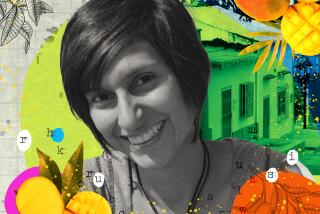Don’t Tense Up, Read ‘Spanish for Gringos’
- Share via
So, you’ve always wanted to learn to speak Spanish, but the idea of drills, work sheets and tests scares you off.
Fear no more. William C. Harvey of Costa Mesa has written a book just for you.
It’s called “Spanish for Gringos,” and it’s designed specifically for those of us who would like to learn Spanish quickly and effortlessly.
The large-format, paperback book (Barron’s; $8.95) offers what Harvey calls “a series of practical, easy-to-follow shortcuts, tips and secrets to success--designed specifically for folks who aren’t interested in ‘studying’ a foreign language.”
In fact, Harvey, a 15-year veteran of teaching Spanish and English as a second language, maintains that Spanish is learned most easily when you understand the “message” and not when you memorize grammar rules.
The self-teaching book, which grew out of Harvey’s popular “Spanish for Gringos” classes, emphasizes key Spanish words and phrases and offers tips for pronunciation and comprehension.
“Spanish for Gringos” is based on the propositions that Spanish is a lot like English, Spanish is not complicated and “it’s OK if you blow it.”
“This language is the easiest language in the world to learn,” said Harvey, who teaches English as a second language at McFadden Intermediate School in Santa Ana.
“My whole mission is to get every gringo who does not speak Spanish to look at Spanish differently the very first time--to try and focus on what really matters and eliminate this mystique, this fear, about learning Spanish that we have.”
Harvey, 36, said the book’s approach is based partly on the way he began picking up Spanish as a Santa Ana teen-ager working as a busboy in a 1st Street restaurant.
“I was the only English speaker in the back room,” he said. “I picked up some one-liners, and I learned how to fake it in order to basically survive in a workplace. And in school in Santa Ana I had a lot of Latino friends. You kind of record things that really work: shortcuts. I just kept a mental record of what worked and didn’t work.”
Harvey collected more language-teaching tips and shortcuts as an ESL teacher. But more important, he said, is what happened to him in 1984 while working on his master’s degree at Cal State Fullerton where he received the Project of the Year award for his work in ESL curriculum development.
“I got excited with what was happening in language training worldwide,” he said. “I found they had been doing what I had been doing for years: Make it easy, make it comfortable, make it comprehensible. What you give them has to be something they can understand as opposed to abstract training.”
What works best in teaching languages, Harvey said, “is a collection of really fun and easy-to-use techniques. A lot of it is based on what is now called the natural approach”--teaching a second language much the way we learn our first language: Beginning with the silent phase and progressing to early speech and intermediate fluency.
“If you introduce material that is too complex too soon, there’s going to be blockage,” he said.
In 1986, Harvey decided to apply the information he had compiled by putting together his “Spanish for Gringos” programs in which participants meet two hours a week for six to eight weeks.
Harvey, who held his first Spanish in a Day seminar for 80 participants at the Red Lion Inn in Costa Mesa in September, said he has trained government office workers for the cities of Long Beach, Santa Ana and Anaheim, in addition to police department, business, hotel, medical and school district employees.
“What people get is a whole new look at the language itself, and I let them see how simple it really is,” said Harvey, who is described as a dynamic, motivational speaker.
“The biggest thing we overcome is fear: They no longer are afraid to learn. By using simple, practical techniques, the learners begin to acquire only the necessary skills, like how to listen to someone speaking Spanish real fast and how to communicate nonverbally.”
Harvey said he’s not guaranteeing fluency. “I’m guaranteeing the ability to understand and speak for the very first time. They have everything they need to become a fluent speaker.
“For the first time they feel confident about being with Spanish speakers. They’re able to (speak Spanish) with lousy grammar and pronunciation. The grammar will repair itself. Spanish spoken poorly makes it much easier when you go for it.”
And after someone completes his course or book?
“I tell everybody, ‘Don’t ever stop learning,’ ” Harvey said. “I think the No. 1 focus throughout the book is, ‘Doggone it, try it. Go for it.’ The (Spanish-speaking) people are there. They’re everywhere. They’re your teachers. Make friends with Marie, sit with Marie and find out the names of things.
“They’re walking dictionaries, for heavens sake. Learn from the people.”
Harvey, who has a “Spanish for Gringos” video in preproduction and is working on two more books, notes that by the year 2000 about 30 million Latinos will be living in the United States, many of them in Southern California.
“The bottom line is there are people entering this country, especially in Southern California, that speak Spanish and Spanish only,” he said. “Wouldn’t it be neat to speak Spanish back?
“And that’s all I say. It’s easy and fun and let me show you how it’s easy and fun.”
More to Read
Sign up for Essential California
The most important California stories and recommendations in your inbox every morning.
You may occasionally receive promotional content from the Los Angeles Times.













